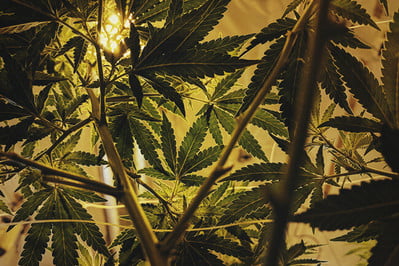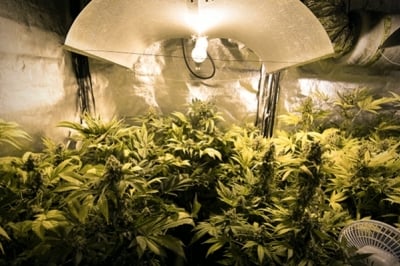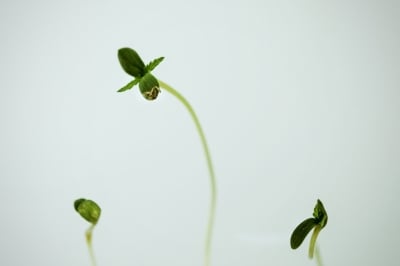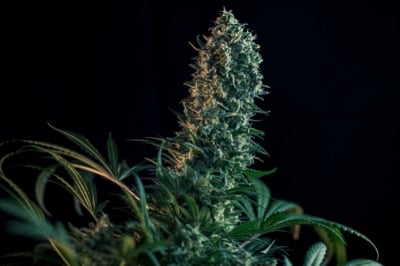Included FREE items

How to Control and Prevent Stretching in Cannabis Plants
- Growing cannabis step by step
- Cannabis growing basics
- Choosing your seeds
- How to germinate seeds
- The cannabis vegetative stage
- The cannabis flowering stage
- Harvesting cannabis
- Trimming, drying, and curing
- Choosing pots and soil
-
Growing indoors
- A Complete Overview Of Growing Cannabis Indoors
- Cannabis Cultivation Tips: How To Set Up Indoor Grow Lights
- How Many Cannabis Plants Can You Grow Per Square Metre?
- Indoor Cannabis Growing: Relative Humidity and Temperatures
- Hydroponics Cannabis Growing Guide (with diagrams)
- Cannabis Micro Growing: Growing Great Weed in Tiny Spaces
- Growing outdoors
- How to grow autoflowering cannabis
- Cannabis nutrients and pH
- Cannabis troubleshooting: Nutrients
-
Cannabis troubleshooting: Growing
- Cannabis Seed Germination — Troubleshooting Guide
- How to Deal With Pythium (Root Rot) in Cannabis Plants
- Slow Cannabis Plant Growth And What You Can Do About It
- How to Prevent and Fix Stretching in Cannabis Seedlings
- Watering Your Cannabis: How To Fix Over And Underwatering
- Understanding Male, Female, And Hermaphrodite Cannabis
- Identifying and Treating Common Cannabis Ailments
- How To Revive a Sick Cannabis Plant
- How to Avoid Mouldy Weed During Drying and Curing
- How to Prevent and Treat Dry and Crispy Cannabis Leaves
- What Cannabis Leaves Can Tell You
- Yellow Cannabis Leaves
-
Cannabis Strains Grow Report
- HulkBerry Automatic Grow Report
- Blue Cheese Auto Grow Report
- Purple Punch Automatic Grow Report
- Triple G Automatic Grow Report
- Do-Si-Dos Automatic Grow Report
- Green Gelato Automatic Grow Report
- Haze Berry Automatic Grow Report
- Purple Queen Automatic Grow Report
- Cookies Gelato Automatic Grow Report
- Sherbet Queen Automatic Grow Report
- Sweet Skunk Automatic Grow Report
- Medusa F1 Grow Report
- Cannabis plant training
-
Weed growing tips
- The Cannabis Plant Anatomy
- How to preserve seeds
- How Much Sunlight Do Outdoor Cannabis Plants Need To Grow?
- How to Control and Prevent Stretching in Cannabis Plants
- How And When To Transplant Your Cannabis Plants
- My Cannabis Plants Are Growing Too Tall: What Should I Do?
- Should You Worry About Purple Or Red Cannabis Stems?
- What To Do When Your Indoor Cannabis Won’t Flower
- How To Protect Your Cannabis Plants From Heat Stress
- How To Tell If Your Female Cannabis Plant Has Been Pollinated
- Growing Medical Marijuana
- Bud Washing: How to Clean Your Weed
If you grow weed, you’ll soon realise that it can grow impressively fast, at some points shooting up like a lanky teenager. Often, this growth is good and natural. Sometimes, however, stretching in cannabis can be a sign that something in the environment is off.
If spotted and dealt with, it needn’t be much of a problem. In this article, we explain the different reasons cannabis plants stretch (some of them are good), and different ways to control and reduce this behaviour.
Contents:
What Is Cannabis Stretching, and Why Does It Matter?
Stretching in reference to cannabis is a term used to describe sudden, upward growth. It can happen because of environmental stress, genetics, or a combination of the two.
Generally, stretching has a bad rap when it comes to growing weed. And though it is often a sign that something is awry, this isn't always the case. Stretching can, at certain times during a grow, be both a natural and even desirable event.
When it’s undesirable, though, it can be problematic.
Plants that stretch can become spindly, wobbly, and weak, which can lead to frail stems that topple over and even snap. At best, this will stunt bud production and require intervention. At worst, it could damage a plant so much that it hardly produces anything at all.
Stopping the bad kind of stretching before it occurs is your best bet, but sometimes life isn’t perfect. So it’s important to learn how to spot stretching early, and know how to deal with it as quickly as possible.
Why Do Cannabis Plants Stretch?
There are several reasons cannabis plants stretch. Learning to identify the specific reason is crucial, as a misdiagnosis could do more harm than good.
1. Growth Stage and Genetics
During the pre-flowering stage, cannabis plants often exhibit dramatic stem growth, sometimes doubling in height. In all cannabis plants, there is going to be some kind of growth spurt at this point, but some will grow more than others, depending on their genetics.
Strains that contain a high amount of sativa genetics are more likely to stretch a lot compared to indica-dominant plants. Sativas are well-known for growing tall, with large internodal spacing. Indicas, on the other hand, grow smaller and more compact, with buds closer together.
Knowing the genetics of your plant will help you understand whether a burst of stretching is in response to environmental stress or simply a characteristic of the plant you have.
2. Light Exposure
Perhaps the main reason cannabis plants stretch in an unhealthy way is in response to too little light.
In nature, seeds germinate in spring, when light levels are increasing. If they don’t perceive enough light, then their response is to shoot upward in an attempt to break through whatever canopy is above them, blocking out the light.
In an indoor grow, the light might either be too far away or too weak. This will trigger the same response in your cannabis plants. This type of stretching, known at etiolation, can happen at any time during the vegetative stage, but is most marked during the seedling and early vegetative stages.
Your first port of call should be to check that the lights aren’t too far away. If this isn’t the case, they might not be strong enough, or they may even be providing the wrong sort of light.
Young plants prefer bright, blue light. Say you were using powerful lights, but the colour was in the red light spectrum, young plants might still stretch.
In terms of where to position your lights, you want them as close to your plants as possible without burning them. This will ensure they get as much light exposure as possible, thus reducing the likelihood of stretching.
3. Heat
Temperatures above 29°C can cause plants to stretch. The reason they do this is to increase their surface area, thereby allowing for greater transpiration (not dissimilar to sweating, in this context). In transpiration, the plant’s stomata open and water evaporates from them, which in turn pulls new water up from the soil. Regarding heat, the evaporation of water allows the plants to cool themselves a little.
Keeping a thermometer in your grow space should help to avoid this problem.
4. Other Environmental Stressors
Other factors may also lead to stretching in cannabis plants, though these can be harder to identify.
One instance may be that you’re trying to grow too many plants in a space that can’t accommodate them. If a plant feels as though there’s no space to stretch outward, it may try to compensate by exhibiting dramatic upward growth. If all the plants grew laterally amongst one another, then they’d block out the light and cause a build-up of humidity. Next time you’re in the forest, look at the canopy of trees. They hardly ever touch and never become thickly entangled with one another—each tree takes its own space. The same is true of cannabis plants.
Another cause could be that they haven’t been exposed to air movement. In nature, even when the weather is good, the air tends to move a little. And there will always be periods of wind. This air movement causes the plants’ stems to grow more robust, which helps them to support themselves as they mature.
Cannabis plants grown in totally still environments are much more likely to autumn over when they stretch. What’s more, toughening their stems can actually help to stop them from shooting upward so much.
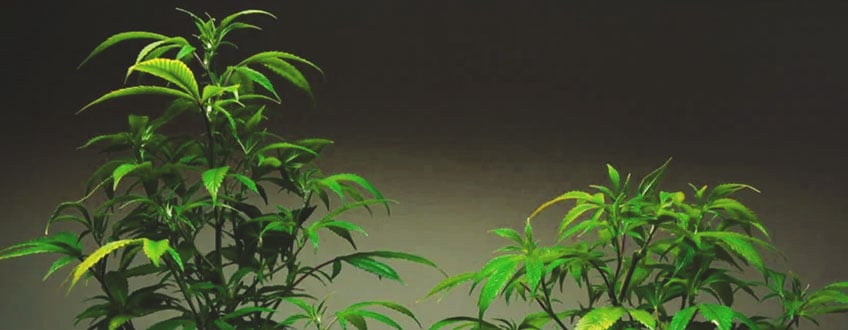
When Do Cannabis Plants Stretch?
Weed plants most often stretch during the night. It’s quite possible to go to bed in the evening, and wake up the next morning and find them much bigger than you remember.
This is especially true during the early flowering stage, when, for a short period, cannabis plants can really bolt upward. This is sometimes known as the “flowering stretch”, and doesn’t indicate an issue with your grow. In fact, stretching during the early flowering stage creates more bud sites, which ultimately leads to a greater yield. So not only is the flowering stretch no bad thing, but it is actually desirable.
How Much Do Cannabis Plants Stretch During Flowering?
All plants will stretch to some degree during the flowering stage, and you shouldn’t be worried, even if it’s quite a lot. Some strains will double in height in a matter of days. What’s important to look out for is whether the stretching stops.
If they continue to stretch for many days, or past double their height, then you might have an environmental issue to sort out too.
Generally, the cannabis flowering stretch lasts for about two weeks, and marks the final period of vertical growth before the plant starts focusing on bud production.

Tips to Control Cannabis Stretching
Now that you know why weed plants stretch, we’ll outline techniques that can be used to help reduce stretching. Whether it's to save space in a grow room or just to keep your plants happy, reducing stretching has many benefits.
1. Strain Choice
First and foremost, certain strains are much more prone to stretching than others. If you have a small grow space and want to keep plant size fairly low, then go for an indica or indica-dominant hybrid. These cultivars tend to grow low and bushy, with denser and more lateral growth.
Especially regarding the flowering stretch, these strains will not shoot up in the same way that lanky sativas are wont to do. They will still stretch, though; there is no avoiding this entirely. Indeed, you wouldn’t want to, as you’d lose out on bud!
2. Keep the Vegetative Stage Short
When plants grow in the early flowering stage, they do so by a proportion of their existing size. A plant that enters flowering at one metre tall could be two metres tall after it has stretched, whereas a 50cm plant will only get up to one metre, or often less.
Therefore, if you need to keep stretching under control, you can shorten the vegetative stage. This means that once you switch your plants over to bloom, they’ll be shorter than if you’d vegged them for longer, and the resulting mature plant will also be shorter.
This method is great for those with small grow spaces, but will inevitably reduce the final size of your plants. As such, it’s a good option for those who have small plants or want to grow particularly large plants but don’t have the space for them.
Alternatively, switching plants over very early, even after just a week or two, is another viable technique, known as SOG (more on this below).
3. Training Techniques
Certain training techniques can help to keep plant growth in check. If executed properly, they should increase overall yield too!
LST
Low-stress training (LST) involves tying a young plant’s stems down laterally, with string or wire. This causes the plant to grow horizontally. The main reason a grower would do this is to increase the surface area of the canopy and the plants’ overall exposure to light. More light means greater bud production and a better yield.
However, another upside to this method is that it keeps plants much lower than if they were left to grow naturally, which can be very helpful for indoor growers.
SOG
SOG, or sea of green, as mentioned briefly above, is a method that involves growing many smaller plants in a small space. It’s achieved by switching cannabis plants over to the flowering period much earlier than usual. This causes the final plants to be much smaller. Although individual plants produce less bud, the overall crop per square metre is often larger, which is why people do it.
But once again, it’s also a great way to keep height under control.
ScrOG
ScrOG is similar to SOG, except the plants are woven through a mesh or trellis, at which point the canopy grows outward, rather than upward. Also, plants needn’t be switched early, as individual large plants can also be placed in a ScrOG setup.
When you set the height of the mesh with ScrOG, you also set the height of the final canopy, so it’s a good way to decide exactly how high your final plants are going to get.
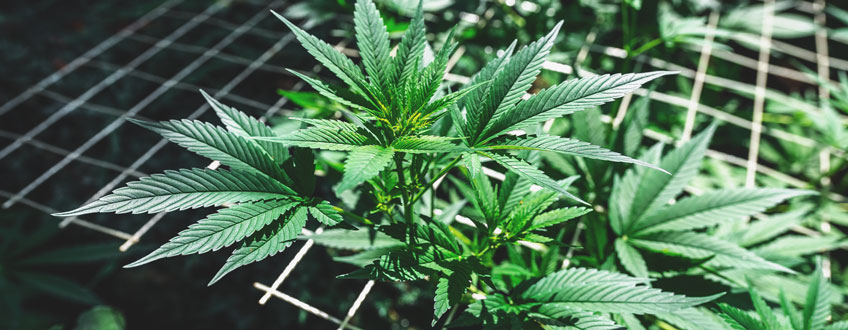
4. Give Plants Plenty of Light
Ensuring your plants have adequate light is perhaps the best way to keep them from unduly stretching.
These days, LEDs are considered, by some, the best and most cost-effective way to light cannabis. However, it’s important to choose high-quality LED lights, as some will not have the right frequencies to effectively grow weed.
Alternatively, you can use more old-school grow lights, such as HIDs; these are tried and tested, and certain to give your plants adequate amounts of the right type of light.
In terms of how far your lights should be from your plants, it all comes down to wattage and type of light—it can vary quite dramatically. Here are a few examples of the recommended distance for a given wattage, but these figures should not be taken as gospel.
- 150 watts: 20–30cm
- 400 watts: 30–48cm
- 1000 watts: 41–79cm
If in doubt, read the instructions! Good-quality lights will indicate how far they should be hung from the canopy.
5. Keep Airflow and Temperature Balanced
Finally, controlling temperature and airflow will help to stop cannabis plant stretching. Keep temperatures below 29°C and make sure that air is moving. This helps to strengthen stems, and stops heat and humidity from building up below the canopy, which can also cause plants to stretch.
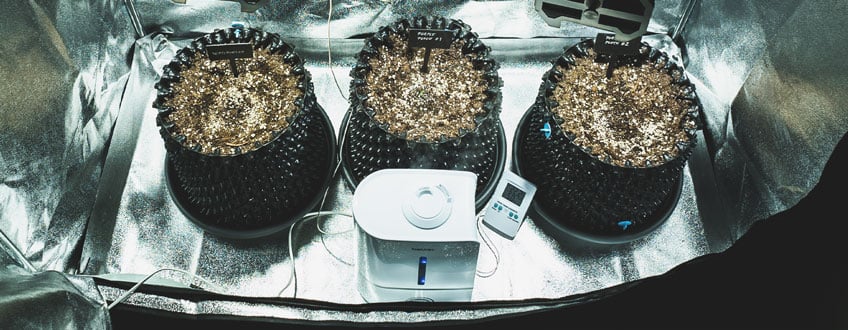
Can You Stop a Cannabis Plant From Stretching?
Not entirely, nor would you want to!
Stretching, in many cases, is just a natural and desirable stage of growth that will lead to more bud sites.
In the cases where environmental stress is causing plants to stretch, then you can stop it. If you prevent it, you’ll generally have a better grow, with healthier and more productive plants. That being said, a little stretching is not a crisis! Your setup will not always be perfect, and a plant can stretch without suffering, so long as you act quickly and appropriately.
Controlled Growth Equals Big Buds!
Ultimately, it all comes down to controlling the environment and treating your weed plants as well as you can. If you do this, you won’t just keep stretching to a minimum, but you’ll foster conditions in which your plants can grow into highly productive beasts, landing you a monster harvest at the end!


























